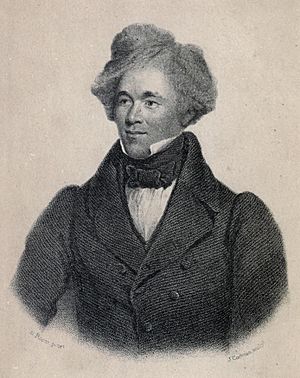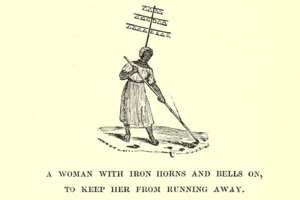Moses Roper facts for kids
Quick facts for kids
Moses Roper
|
|
|---|---|
 |
|
| Born | c. 1815 |
| Died | April 18, 1891 |
| Education | Hackney, University College London |
| Occupation | Writer, lecturer |
Moses Roper (born around 1815 – died April 15, 1891) was an African American writer and speaker. He worked to end slavery. He wrote an important book about his experiences as an enslaved person. It was called Narrative of the Adventures and Escape of Moses Roper from American Slavery. He also gave many talks in Great Britain and Ireland. His goal was to show people in Europe how cruel slavery was in America.
Contents
Moses Roper's Early Life
Moses Roper was born around 1815 in Caswell County, North Carolina. His father, Henry Roper, was a white plantation owner who also enslaved Moses. His mother, Nancy, was of African American and Native American background. She was also enslaved by Henry Roper.
When Moses was seven, he was taken away from his mother. They did not see each other again for many years. Moses was enslaved by different people in North Carolina and Florida. He later said he tried to escape between 16 and 20 times. Each time, he was caught.
Escaping Slavery
In his book, Moses described how he finally escaped. While in Georgia, he met some farmers. They helped him by writing a fake travel pass for him. This pass made it seem like he was a free person.
Moses eventually reached New York. He then moved to Massachusetts and Vermont for short times. He was afraid of being caught by slave catchers. These people were active in the area. Because his father was white, Moses could sometimes pass as a white person. Friends told him to join the U.S. Army to stay safe.
Instead, with help from American abolitionists, Moses got on a ship. It was going to Great Britain. He settled in London. There, he published his book, Narrative of the Adventures and Escape of Moses Roper from American Slavery. This book was very important. It shared his firsthand stories of the terrible things he saw and experienced in slavery. The 1838 version of his book had five pictures. It was one of the first illustrated books by an enslaved African American.
During his talks in Great Britain and Ireland, Moses shared these stories. He also showed tools used to hurt enslaved people. These included whips, chains, and handcuffs. He wanted to show how brutal American slavery was. In April 1838, at a meeting in Sheffield, he showed whips and a tool called a "negro flapper." This tool was used to beat field slaves.
Working to End Slavery in Britain
Moses Roper's support in England was well-planned. He carried letters that introduced him to important people. These included Rev. Dr. Fletcher, Rev. Dr. Morison, and Rev. Dr. Raffles. Through them, he met other helpful supporters. These included Rev. Dr. T. Price and Rev. F. Cox. He also met leading British abolitionists like Thomas Fowell Buxton.
Moses was not allowed to learn to read or write while enslaved in the United States. But in England, he got the chance. He studied in Hackney, Wallingford in Oxfordshire. Then he went to the University of London.
He wrote about his education:
At Hackney I stayed for six months. I learned the basics of an English education. During this time, I attended Dr Cox's church, which I really enjoyed. I will always remember the kindness of Rev. Dr. Morison. I can truly say he was very kind to me.
His supporters then helped him travel around the country. He visited churches to teach people about American slavery. They also helped him sell and promote his book.
Moses traveled all over England, Ireland, Scotland, and Wales. He spoke about why slavery in the U.S. should end.
Public Speaking and Impact
In London, he gave two of his first speeches in May 1836. One was at Rev. Thomas Price's Baptist Chapel. The other was at Rev. Alexander Fletcher's Finsbury Chapel. Both talks drew large crowds. Newspapers reported on them widely. This helped change British views on American slavery.
A newspaper reporter described Moses's speech in Bradford in 1840. The reporter said Moses showed tools used to punish enslaved people. He also shared sad stories of their suffering. He talked about how slavery hurt even the white people in the Southern States of America. The reporter noted that Moses's stories of escape deeply moved his listeners. He also recited poems. Moses sadly spoke about his mother, who had died before he could free her. He worried about his brothers and sisters. They had been sold to far-off states, and he had not heard from them. He said he still loved America. He also mentioned that the English weather was hard for him. But becoming a British citizen was his strong wish, though he could not afford it.
Moses challenged common ideas about American slavery. In a speech in Leicester in 1838, he said: "Many will say 'This is the slaves’ side of the story. The slave-holders would tell a different story.' You have heard the slave-holders’ story 250 years ago. Now, I think it is time for the slaves to speak."
By 1848, his book had sold over 38,000 copies. More than 5,000 of these were in the Welsh language. He gave over 2,000 talks across Britain and Ireland. He spoke in Baptist, Independent, Methodist, and Quaker churches. He also spoke in town halls in almost every county in Britain. He was one of the few activists to speak in the Scottish Highlands. Moses traveled to many rural places, like Cornwall and Wales. This shows how much he traveled for his lectures.
Even with all the positive feedback, some people did not believe Moses. They accused him of lying about the harshness of American slavery.
Later Life and Family
Moses Roper married Ann Stephen Price in Bristol, England, on December 21, 1839. They had four daughters. One was born on the Atlantic Ocean on the way to Canada around 1844. Two were born in Quebec. The youngest was born in Nova Scotia between 1850 and 1857.
He returned to the United Kingdom three times. First, in 1846, to "settle private matters." This might have been to arrange a new edition of his book. Then, in 1854, and again before 1861, to give more talks. The last time, he brought his wife and daughters back. The 1861 British Census shows them living with his father-in-law in Merthyr Tydfil, Glamorgan, Wales. Moses was in Cambridge, England, staying in a boarding house.
After 1861, Moses Roper went back to the U.S. He became a traveling speaker. He gave talks on many topics, like "Africa and the African People" and "Causes of the Colors of the Races." He also spoke about the "Holy Land."
It seems his family never heard from him again after he returned to the U.S. By 1871, his wife had remarried. When his youngest daughter, Alice Mary Maud Roper, married in 1883, Moses's name was listed as "(deceased)."
Final Years
Several years before he died, Moses Roper traveled through New England. He took any job he could find. In April 1891, he was working on a farm in Franklin County, Maine, near Strong. His health failed him. Moses was in very poor physical shape. He had a little over a hundred dollars and was with his dog, Pete. Pete was described as his "faithful companion." Moses was put on a train to Boston, Massachusetts.
Moses and his dog made it to Boston. But he was found unconscious at a train station. He was taken to the Boston City Hospital. When he was found, he was wearing four shirts, two overcoats, and three pairs of pants to stay warm. He was suffering from heart and kidney problems, and also eczema. These health issues led to his death on April 15, 1891. His dog had to be pulled away from his bedside. Moses Roper was buried in a pauper's grave in Boston. This means he was buried in a simple grave for people who could not afford a private one. However, newspapers in America noted how important his work was to end slavery in both the U.S. and Europe.
See also


